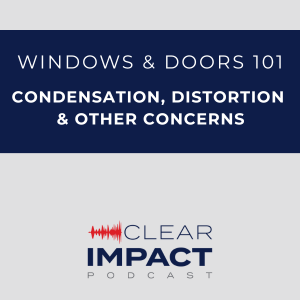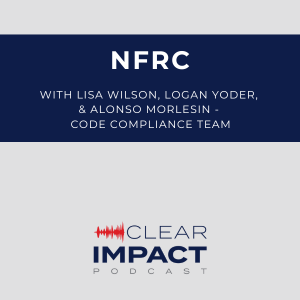Episode Transcript
[00:00:00] Speaker A: Foreign.
[00:00:08] Speaker B: Welcome to the Clear Impact Podcast, brought to you by Mitre Brands University. Thanks for joining us today. My name is Sheri Conner and I am your host.
[00:00:24] Speaker C: So, good morning. We are here on the Clear Impact Podcast, and we are in a series called windows and doors 101. And this is really for homeowners, people who are new to the industry. Windows and Doors can be very complex, and most people don't realize that unless they're already familiar with the industry.
And so, in studio, we have with us Patrick Jamison. Welcome.
[00:00:49] Speaker A: Thank you. Good morning. Good morning.
[00:00:51] Speaker C: Nice to have you. So, Patrick, tell us a little bit about you.
[00:00:54] Speaker A: Well, I have been at PGT since 2001, working in a variety of departments and been in the university department going on 10 years. And it has just been a wonderful journey going through the different departments, meeting a lot of people from all over, and all the different experiences, different tasks and jobs I've been involved with really helped me where I'm at today.
[00:01:17] Speaker C: Yeah, because you know, the product inside and out and working on the line and being in shipping and receiving, working upstairs, you've had a lot of different experiences, so.
[00:01:27] Speaker A: Yes, I have. And it's been just a really fun journey.
[00:01:31] Speaker C: Yeah. A nice resource for stories. Yes.
So, Patrick, what is your current role?
[00:01:36] Speaker A: My role is senior specialist dealer training. So my ultimate role is to work with our customers, whether it's via webinar, in person at a conference event, and give them information they're looking for, whether it's about products, installation, or building code.
[00:01:53] Speaker C: And you are just a giant wealth of knowledge. Like, we are so grateful to have you on our team. And I know personally I can go to you and just say, hey, I don't understand this, or I'm not sure about that. So I really appreciate having you as a resource for what I do. So today we're gonna talk about design pressure.
[00:02:11] Speaker A: Oh, design pressure.
[00:02:12] Speaker C: Okay, we're gonna talk about design pressure. And so I joke around that design pressure is how I feel after watching HGTV for any amount of time. Like, I need to redecorate and I, you know, order new rugs and get new paintings and, you know, maybe knock down a wall or two. But what is design pressure when it comes to fenestration?
[00:02:32] Speaker A: Oof. That's a heck of a question there, because that's something that we discuss in class. Design pressure is this formula that calculates not only wind speed, but water. It determines what your windows need to meet in that area, in that municipality, in that jurisdiction. If you're greater than 30ft up in the air. If you're on the beach, if you're surrounded by woods, the local buildings department's gonna determine that you need to meet X design pressure. And it's a really good thing. The bigger the number, the better the testing or the better the product is up against the wind, the water, et cetera.
[00:03:09] Speaker C: Okay, so how does that connect to like hurricane categories or wind speed? Cause if you're buying windows, you're not saying, I want windows that are gonna meet a cat 3 or a cat 4.
[00:03:21] Speaker B: Right.
[00:03:21] Speaker C: That's not how the windows are.
[00:03:23] Speaker A: And that's what a lot of homeowners have this belief that I want to have hurricane proof windows. When we don't. We have hurricane resistant windows. Every storm has its own name, it has its own personality. And we have windows that meet both positive and negative design pressures. Because some homeowners think it's only wind. Wind is what's going to get inside my house and blow the roof off. Well, back in 2004, 2005, we had about 14 or 15 named storms hit Florida. More than 80% of all their insurance claims was not because of wind. It was because of water, dam. And that's a huge thing. And that's what we have to test for when we're doing design pressure to see how it's going to perform when a lot of this water is trying to infiltrate and breach inside the products. So your positive number is going to be all that positive wind pressure water trying to get in. Well, if a homeowner or a dealer sees any of those like 4 inch by 8 inch labels that show design pressure numbers, they're going to see a positive and a negative number. The negative number will always be the same or greater than the positive because it's the pressure of being like sucked out of the wall or the glass getting sucked out of the frame. It's going to be a greater number because you can't pull water backwards. The positive number only has the water. And the negative number is that pressure of getting like sucked out. But we have to test the products both positive and negative. Because of when a hurricane passes by, the directions of the wind are going to change. And that window, that door needs to be tested in all directions.
[00:04:58] Speaker B: We are sharing our expertise around all topics relating to the window and door industry. Whether you are a customer selling our products or a homeowner doing research, the Clear Impact podcast provides helpful content that makes an impact. Subscribe today wherever you listen to podcasts.
[00:05:15] Speaker C: Yeah. Cause you never know.
[00:05:17] Speaker A: You never know.
[00:05:17] Speaker C: Yeah.
[00:05:18] Speaker A: Mother Nature's funny sometimes.
[00:05:20] Speaker C: And for those that are not living in hurricane zones, is there still design pressure in other areas? Are all products tested?
[00:05:28] Speaker A: All products are tested. All products have to be tested. They're just not going to be that strict. You're not going to have a plus 100, minus 100 requirement, for example, up in Kansas or Minnesota or something like that. So there are still going to be design pressure requirements, but they're going to be very low. Something like more up north is going to be more focused on energy. But where I live in Alabama, we get a good amount of wind that comes through every year with the rain. And I've got some PGT product. I haven't done my whole house yet, but I'm working on getting everything PGT enforced or reinforced.
[00:06:03] Speaker C: Nice. And so how does somebody find out what design pressures they need to have?
[00:06:08] Speaker A: Really? I would always suggest going to your local dealer, go to one of our customers. They are in the business. They know exactly where to go to find that information. You can do your research if you want to go down to local buildings, office and say, hey, I live in this area, on this street. Here's my house. Can you give me an idea of what is required for design pressure for me? And they would, I would think, give you that information. And then there's also websites out there. I think engineeringexpress.com can be a great resource. That's something that a lot of architects use as well.
[00:06:42] Speaker C: So for design pressure, is it the same like, okay, so my house is a plus 50, minus 60, or does it vary from second story to first story or the back of the house to the front of the house? Or does it, like, what are the different things that you have to keep in mind?
[00:06:58] Speaker A: Yes. To all those questions. Okay, so, yes, it can all vary. Your house could be just one story. It could be multiple stories. And different windows could require different design pressures. What we call the end zones, the windows and doors within four feet of a corner of the house most likely will require a higher design pressure than a window that's greater than 4ft away from the corner of a house. So we have different areas of the different parts of the house that could require a higher design pressure. The higher you go, you could be required to have a higher design pressure. Your insurance company might require you to have shutters and impact windows with the products that face the ocean, for example. Not all insurance companies do this, but there has been cases out there where insurance companies require this because they know if you have shutters in front of Your windows, that's going to help with better water protection.
[00:07:51] Speaker C: Okay. So it's a pretty important formula and it's really an engineering formula and it's really for us to meet the appropriate requirements for your house or commercial building or whatever it is that you're correct.
[00:08:07] Speaker A: And with all the different options that we have, from our glass makeups to whether it's annealed, he strengthened. If it's tempered, if it needs a high sill riser, even some high sills on single hungs, we have so many different options to achieve different design pressures. We can go basic and we can really put some components in these products. That's going to bump up that design pressure pretty good.
[00:08:30] Speaker C: Okay, so that's a good overview of what design pressure is. Do you have any fun or interesting stories that you can share about this?
[00:08:37] Speaker A: A fun story. Well, I remember back in the day when I worked in consumer affairs, I had a homeowner call up and they were mad because their window was leaking. They were doing their own field test. And I asked the gentleman, I said, well, how are you testing the product yourself? He says, I'm using my pressure washer. He says, it's a 3100 psi. I'm sticking it right up by the weep hole and water is just blowing in. And I explained to him, I was like, you know, that is so wrong in so many different ways. I said, one, the products are not tested to 3100 psi. He got mad. He actually argued with me, saying, well, there's no way that this pressure washer is stronger than a hurricane. It's like, yes, it is. You're putting in a quarter size diameter, 3,100 psi pounds per square inch. And that is a lot of pressure. And if we had a hurricane like that, I said we'd be leveled. So I explained to them that we don't test that way. Also, you have a chance of like causing so much damage to the window. If you had an air spacer, it's going to break the seal. It's going to do a lot of damage. Then good. So no, put the pressure washer down. But yeah, he wanted to mimic design pressure. He wanted to mimic wind driven rain and that it was the wrong way of doing it.
[00:09:49] Speaker C: Oh, gosh. Yeah. People are funny, right? Well, Patrick, I appreciate your time and your expertise. Thank you for explaining this topic, which can be very confusing for people and any. Anyway, have a great day.
[00:09:59] Speaker A: Oh, thank you, thank you. I had a great time and have yourself a great day as well.
[00:10:02] Speaker C: Thank you all right. Thanks.
[00:10:06] Speaker B: The Clear Impact podcast is brought to you by Mitre Brands University. We are a part of Mitre Brands, a family of leading window and door brands united by our passion for quality and relentless pursuit of 100%. At Mitre Brands, our common purpose is to deliver value by manufacturing the finest products, services and customer experience every day, everywhere. Our window and door brands deliver regionalized expertise, products and services, all backed by a national company. Mitre Brands University is here to educate you, our listener, so that you can be a more informed consumer of window and door products.


